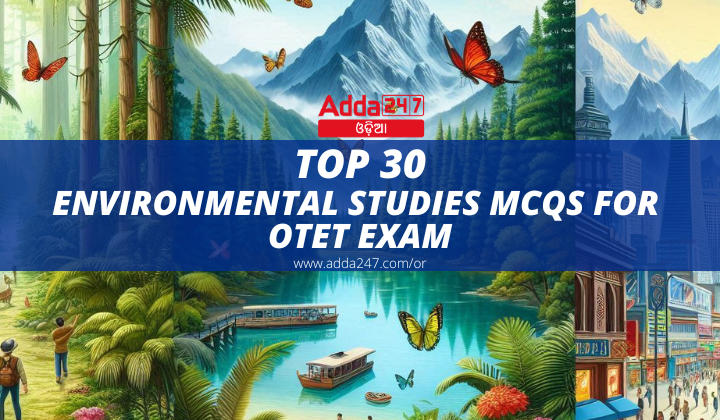The top 30 Environmental Studies MCQs for the OTET exam are tailored to help aspiring teachers grasp essential environmental concepts and issues. These questions delve into topics such as biodiversity, conservation, pollution, climate change, and sustainable development. By focusing on both theoretical knowledge and practical applications, this set of MCQs aims to equip candidates with a comprehensive understanding of environmental science, crucial for educating future generations. The carefully curated questions ensure that candidates are well-prepared to tackle the environmental studies section of the OTET exam with confidence and proficiency.
Top 30 Environmental Studies MCQS For OTET Exam
- What is the significance of integrating Science and Social Science in education?
(a) Enhances interdisciplinary understanding
(b) Increases workload for students
(c) Limits academic focus
(d) Reduces practical learning opportunities
Ans. (a) Enhances interdisciplinary understanding - Which method is NOT commonly used in teaching Environmental Studies (EVS)?
(a) Survey
(b) Practical Work
(c) Lecture-based
(d) Project
Ans. (c) Lecture-based - What is a key principle of teaching EVS?(a) Rote learning
(b) Activity-based learning
(c) Memorization
(d) Instructional teaching
Ans. (b) Activity-based learning - Which approach in teaching EVS focuses on hands-on learning experiences?(a) Lecture-based approach
(b) Theory-based approach
(c) Activity-based approach
(d) Textbook-based approach
Ans. (c) Activity-based approach - Which evaluation technique is useful for understanding students’ prior knowledge in EVS?(a) Summative assessment
(b) Formative assessment
(c) Diagnostic assessment
(d) Continuous assessment
Ans. (c) Diagnostic assessment - Local self-government is a feature of which level of governance in India?
(a) Central Government
(b) State Government
(c) Municipal Government
(d) Village Government
Ans. (c) Municipal Government - Which physical feature is characteristic of Odisha and India?
(a) Mountains
(b) Deserts
(c) Plateaus
(d) Plains
Ans. (d) Plains - Which factor primarily determines the climate of a region?
(a) Soil type
(b) Wind patterns
(c) Population density
(d) Vegetation cover
Ans. (b) Wind patterns - What percentage of India’s geographical area is covered by agriculture?
(a) 30%
(b) 40%
(c) 43%
(d) 50%
Ans. (c) 43% - Which sector provides essential services to both industries and agriculture in India?
(a) Primary sector
(b) Secondary sector
(c) Tertiary sector
(d) Quaternary sector
Ans. (c) Tertiary sector - Which industry directly relies on the agricultural sector for raw materials such as cotton and sugarcane?
(a) Automobile industry
(b) Textile industry
(c) IT industry
(d) Pharmaceutical industry
Ans. (b) Textile industry - Which agricultural policy aimed at sustainable and inclusive growth during the Tenth Five-Year Plan?
(a) Green Revolution Policy
(b) National Agricultural Policy
(c) Industrial Policy
(d) Economic Policy
Ans. (b) National Agricultural Policy - During which Five-Year Plan did India witness the Second Green Revolution in agriculture?
(a) Fourth Plan
(b) Fifth Plan
(c) Sixth Plan
(d) Seventh Plan
Ans. (c) Sixth Plan - Which amendment to the Indian Constitution added Fundamental Duties, including environmental protection relevant to agriculture?
(a) 42nd Amendment
(b) 44th Amendment
(c) 73rd Amendment
(d) 86th Amendment
Ans. (a) 42nd Amendment - What was the agricultural growth rate during the Eleventh Five-Year Plan?
(a) 1.5%
(b) 2.5%
(c) 3.5%
(d) 4.5%
Ans. (c) 3.6% - Which plan aimed at solving the food crisis as the highest priority with a significant allocation to agriculture?
(a) First Plan
(b) Second Plan
(c) Third Plan
(d) Fourth Plan
Ans. (a) First Plan - Which agricultural input saw expanded supply during the Sixth Five-Year Plan, contributing to increased agricultural productivity?
(a) Fertilizers
(b) Pesticides
(c) Seeds
(d) Water
Ans. (a) Fertilizers - During which plan did India witness a growth rate of -0.2% in agriculture due to challenges?
(a) Eleventh Plan
(b) Twelfth Plan
(c) Tenth Plan
(d) Ninth Plan
Ans. (b) Twelfth Plan - What was the agricultural growth rate during the Eighth Five-Year Plan?
(a) 3.68%
(b) 4.68%
(c) 5.68%
(d) 6.68%
Ans. (b) 4.68% - Which climatic region of India experiences a monsoon type with dry winters?
(a) Tropical Savanna type (Aw)
(b) Semi-arid steppe climate (BShw)
(c) Hot desert type (BWhw)
(d) Monsoon type with dry winters (Cwg)
Ans. (d) Monsoon type with dry winters (Cwg) - Which sector provides banking services crucial for agricultural financing in India?
(a) Primary sector
(b) Secondary sector
(c) Tertiary sector
(d) Quaternary sector
Ans. (c) Tertiary sector - During which plan did India focus on the application of science and technology in agriculture?
(a) Fourth Plan
(b) Fifth Plan
(c) Sixth Plan
(d) Seventh Plan
Ans. (a) Fourth Plan - Which climate type is found in almost the entire peninsular region of India?
(a) Tropical Savanna type (Aw)
(b) Semi-arid steppe climate (BShw)
(c) Hot desert type (BWhw)
(d) Monsoon type with dry winters (Cwg)
Ans. (a) Tropical Savanna type (Aw) - Which agricultural sector saw a decline in its contribution to GDP in 2022-23?
(a) Primary sector
(b) Secondary sector
(c) Tertiary sector
(d) Quaternary sector
Ans. (a) Primary sector - Which policy aimed at solving the food crisis during the First Five-Year Plan?
(a) Green Revolution Policy
(b) National Agricultural Policy
(c) Industrial Policy
(d) Economic Policy
Ans. (b) National Agricultural Policy - During which plan did India witness a significant reduction in agricultural outlay?
(a) First Plan
(b) Second Plan
(c) Third Plan
(d) Fourth Plan
Ans. (b) Second Plan - Which agricultural input saw increased supply during the Seventh Five-Year Plan contributing to enhanced productivity?
(a) Fertilizers
(b) Pesticides
(c) Seeds
(d) Water
Ans. (a) Fertilizers - Which amendment aimed at adding environmental protection as a fundamental duty in the Indian Constitution relevant to agriculture?
(a) 42nd Amendment
(b) 44th Amendment
(c) 73rd Amendment
(d) 86th Amendment
Ans. (a) 42nd Amendment - Which climatic region of India experiences a hot desert type climate?
(a) Tropical Savanna type (Aw)
(b) Semi-arid steppe climate (BShw)
(c) Hot desert type (BWhw)
(d) Monsoon type with dry winters (Cwg)
Ans. (c) Hot desert type (BWhw) - Which agricultural input saw expanded supply during the Sixth Five-Year Plan, contributing to increased agricultural productivity?
(a) Fertilizers
(b) Pesticides
(c) Seeds
(d) Water
Ans. (a) Fertilizers





